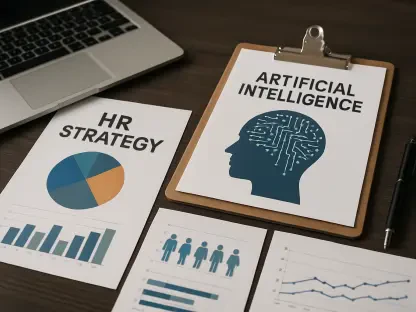Employee engagement in 2024 reached a challenging low, with only 31% of U.S. employees expressing active involvement at work. This significant decline poses a substantial challenge for HR leaders striving to foster a motivated and committed workforce. Contributing factors to this decline include increased dissatisfaction broadcasted through social media and persistent disengagement reported by 17% of employees. These indicators suggest an urgent need for organizations to reassess their strategies to enhance employee morale and satisfaction. Traditional methods of engagement are proving inadequate, necessitating new, innovative approaches to cultivate a work environment that encourages employee participation and fulfillment. The decline since 2020 has been attributed to various forces, including the complexities of work-life balance, managerial burnout, and inefficiencies in performance management systems.
Identifying Key Challenges and Underlying Causes
The mass return to office setups after a period of flexible working arrangements has unexpectedly impacted team dynamics and overall workplace enthusiasm. Many employees, having adapted to remote work benefits, now face disruption in cohesion and engagement. Parallelly, manager burnout remains a critical factor. Given their substantial role in influencing team dynamics, the disengagement among managers — with only 31% feeling engaged — has repercussions for entire teams. Furthermore, performance management systems are seen as failing to meet organizational needs, often causing more confusion than clarity in delineating roles and expectations. As a result, employees find themselves demotivated, unsure of their objectives, and lacking the recognition necessary for sustained engagement. Organizational changes, compounded by inadequate communication, have only added to this mix, making employees feel alienated and stuck. These dynamics especially challenge workers under 35, who find themselves grappling with less defined trajectories in the workplace.
Another underlying factor is the fluctuation in organizational structures and the transformation of employee roles post-Great Resignation, which has intensified feelings of uncertainty and stagnation. The abrupt changes, without sufficient communication and clarity, have led employees to crave clear guidance and consistent recognition now more than ever. This environment, particularly harsh on younger employees, threatens to usher in another wave of mass resignations if left unaddressed. Addressing these multifaceted challenges requires a deep understanding of employee needs and expectations, recognizing the evolving workplace trends, and implementing strategic initiatives to bridge the engagement gap. Evaluating and restructuring standard HR practices to reflect these insights can pave the way for improved employee morale and commitment.
Innovative Strategies for HR Leaders
To effectively address disengagement, HR leaders need to adopt innovative strategies tailored to meet current employee expectations and preferences. A key approach is offering meaningful and personalized benefits, which play a crucial role in maintaining motivation. Generic benefit packages often fail to resonate with employees, leading to feelings of underappreciation. By customizing benefits to align with employee priorities, organizations can foster a sense of value and commitment. Engaging employees through surveys and focus groups can provide insights into benefits that hold the most value, enabling HR to implement creative and cost-effective solutions such as flexible work schedules or ergonomic enhancements like standing desks.
Clarity around job expectations is another crucial component in boosting employee engagement. Gallup’s research indicates a significant drop in employee awareness regarding job roles and objectives, which directly impacts productivity and engagement. Redefining job descriptions and establishing regular feedback mechanisms can provide employees with clear expectations and a sense of purpose, driving productivity. Collaborating with managers to integrate defined competencies and behaviors and regular goal-setting sessions can also ensure alignment of priorities across teams. Providing managers with the necessary tools to foster productive dialogues with their teams further reinforces organizational goals and enhances overall workforce engagement.
Building a Supportive and Growth-Oriented Environment
It’s vital for HR leaders to cultivate an environment that emphasizes care and support, forming genuine connections beyond traditional productivity metrics. Engaged managers are essential in creating meaningful interactions that energize teams and enhance company culture. Providing managers with adequate training and resources to develop genuine relationships with their teams helps foster a nurturing work atmosphere that can lead to increased retention and engagement. When employees feel genuinely cared about, they are more inclined to invest in the organization, positively impacting business outcomes.
Moreover, doubling down on growth and development opportunities is essential in sustaining employee motivation, especially for millennials and Gen Z. A significant portion of employees express feeling constrained in their roles, particularly the younger cohort, who value growth opportunities and purpose-driven work. Programs that offer personalized development plans aligned with organizational goals and personal career aspirations can transform a routine job into a fulfilling career. Empowering employees to connect their individual development with the broader company mission fosters a sense of contribution and significance. Encouraging internal mobility and creating transparent paths for advancement sustain enthusiasm and commitment, driving overall organizational success.
Exploring New Horizons for Employee Engagement
As the landscape of work continues to evolve, it’s imperative for human resources to remain agile and responsive to emerging trends in employee engagement. Technological advancements, shifting expectations, and changing workplace dynamics necessitate continuous adaptation and innovation. Organizations could turn to tech-enhanced solutions, such as AI-driven analytics, to gain insights into engagement trends and customize strategies accordingly. Virtual and hybrid setups offer new avenues to engage with employees across diverse geographic locations, and HR leaders must embrace these advancements to create an inclusive and responsive work environment.
Furthermore, fostering a dialogue around engagement allows for feedback-driven improvements, ensuring the continuous refinement of HR practices. As organizations navigate a rapidly changing world, embracing a culture of learning and adaptation will encourage sustained engagement. By exploring new avenues and maintaining a proactive stance on employee engagement, HR leaders can not only address the current challenges but also anticipate future shifts, positioning their organizations for long-term success.
Strategic Steps for Future Success
The unexpected shift back to office environments after flexible working periods is affecting team dynamics and workplace enthusiasm. Many employees, accustomed to remote work benefits, are now experiencing disruptions in cohesion and engagement. Meanwhile, manager burnout remains a key issue, with only 31% feeling engaged, impacting entire teams. Performance management systems, often unclear, fail to meet organizational needs, leading to confusion about roles and expectations. Consequently, employees feel demotivated and lack the recognition needed for sustained engagement, exacerbated by poor communication during organizational changes. These challenges particularly affect workers under 35, struggling with undefined career paths. The ongoing transformations post-Great Resignation further heighten uncertainty, risking another wave of resignations. Addressing these issues requires understanding employee needs, adapting workplace trends, and strategically improving HR practices to boost morale and commitment.









